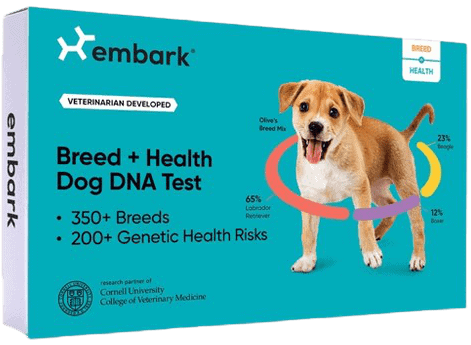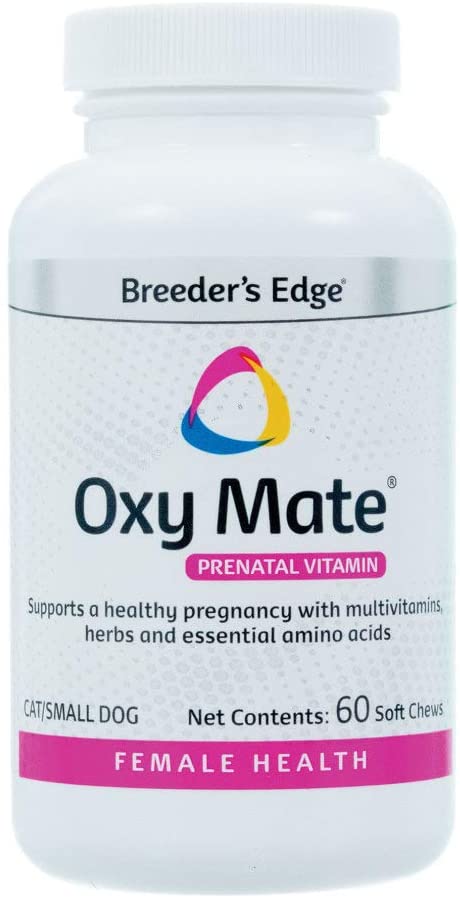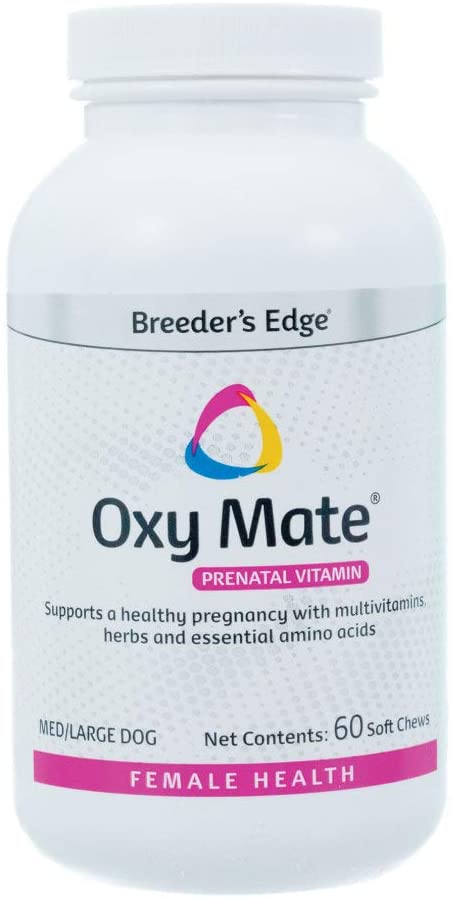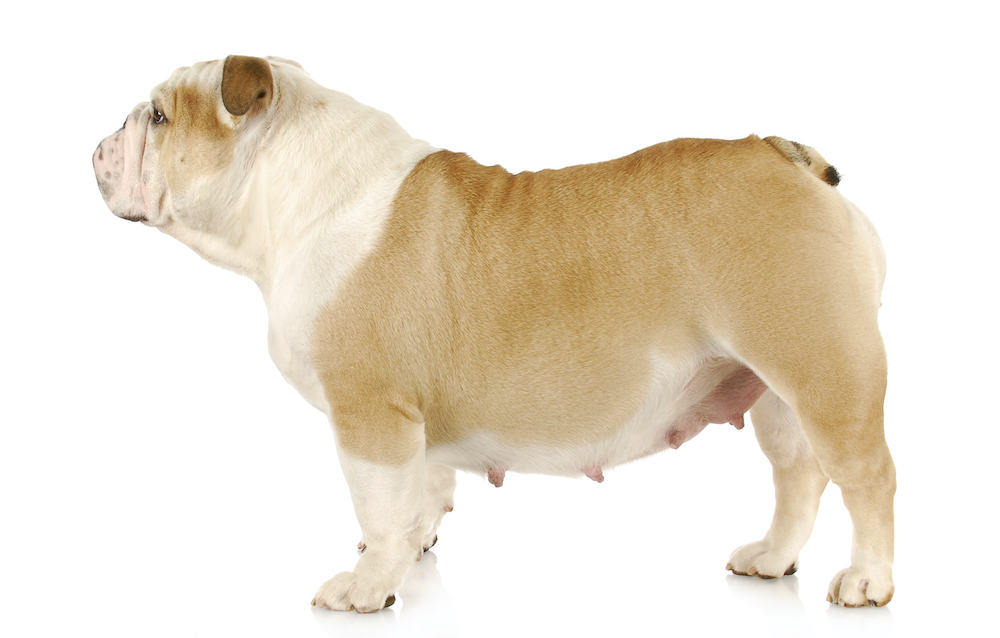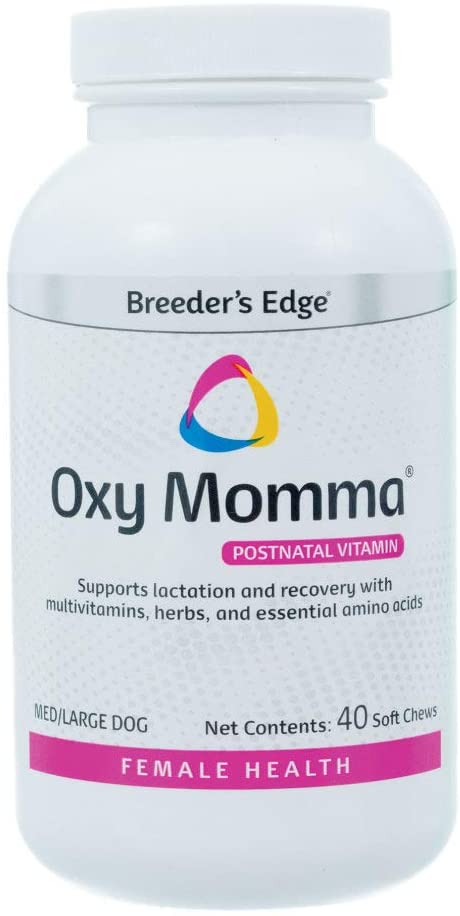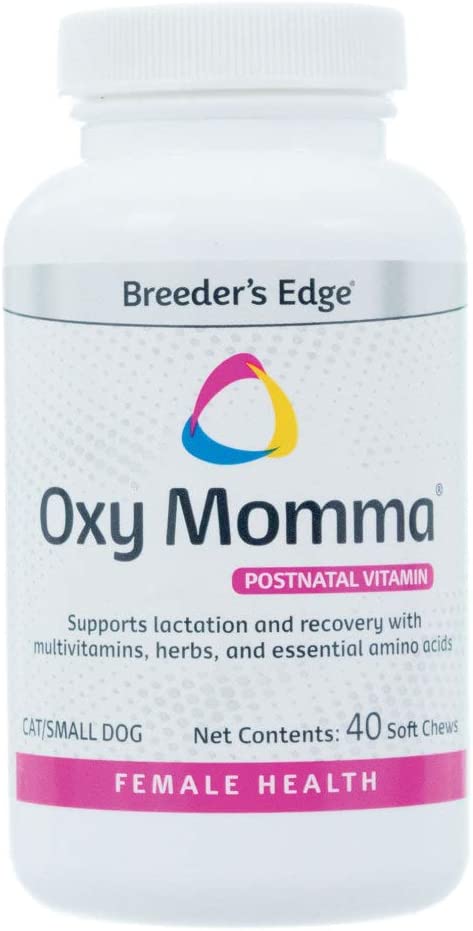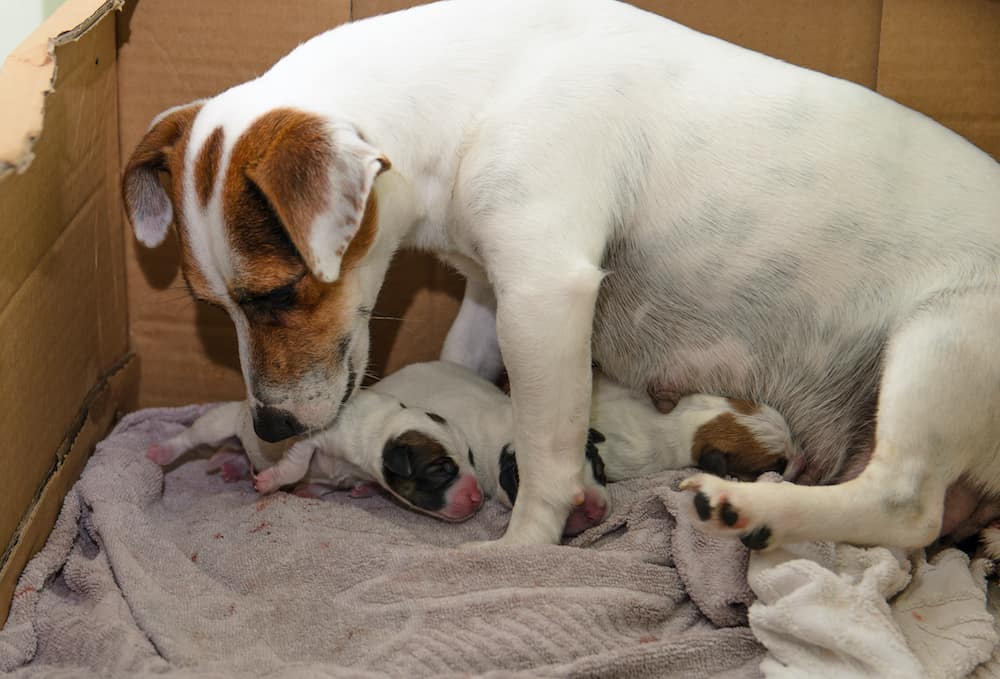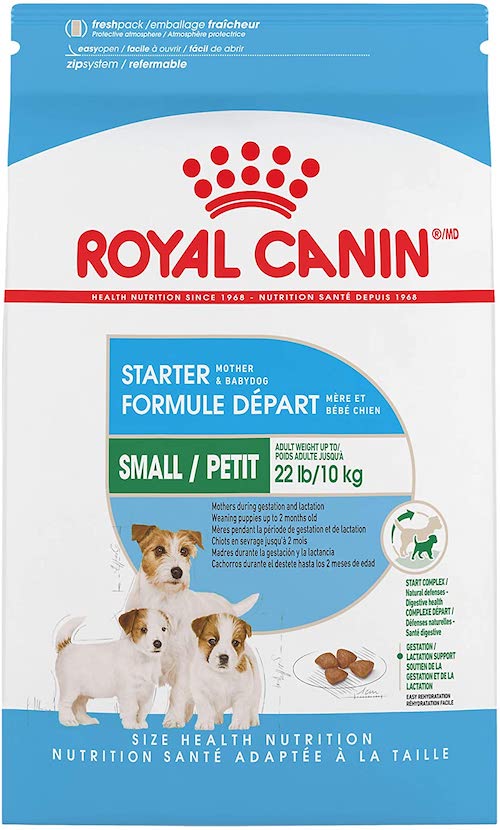
Dog Pregnancy Calculator
Estimate when your dog is due to give birth by entering the date of the first mating below and stay prepared for additions of new puppies to your family!Protect your beloved pets without breaking the bank
- Unlimited video calls & texts with vets
- Available 24/7
- Annual $3,000 emergency fund
- LIMITED TIME - 7 DAYS FREE trial
- SPECIAL OFFER - 20% OFF 1st month
Code: GOODY20
- Flexible coverage
- Hassle free claims
- Multiple pets family plan
Quiz Time!
How Long Is A Dog Pregnant?
A dog's pregnancy lasts about 63 days with 3 trimesters of 21 days each. In the sections below, we will take a closer look at a week by week comparison guide including some of the most important milestones as well as physical changes going on throughout your pooch's pregnancy. You will also learn all you need to know about care tips to have them as healthy and comfortable as possible. Let's get right to it.
Dog Pregnancy Calendar – A Week By Week Comparison
Week 1 (Trimester 1)
It is almost impossible to pinpoint changes in the first week of pregnancy in a dog as there are no visible physical changes.
The first week itself starts with the fusion between a male sperm and an ovum from the female. This process is referred to as fertilization.
The number of eggs to be fertilized depends on the dog breed's litter capacity as well as individual factors like age and general health status.
The newly formed zygotes slowly make their way along the fallopian tubes towards the uterus with the help of little, contracting structures on the liking of the tubes. By the 7th day after conception, they should have reached the horns of the uterus.
Seeing as this is essentially a silent part of the pregnancy, it is likely to go unnoticed. In fact you may not even pick up on any changes with ultrasound imaging during the first few days.
The best you can do for your furry best friend, therefore, is to keep them well-fed, active, and generally happy and comfortable.
If you have a small pooch, they will need as much help as possible so we suggest you start them on prenatal supplements at this stage especially if you are anticipating the pregnancy. Revival Animal Health Breeders' Edge Oxy Mate Prenatal Supplement with iron, zinc, and folic acid are the best in this case.
Week 2 (Trimester 1)
As with the first week, it is still too early to pick out any physical changes in your pregnant dog so you might not be able to tell.
However, there are microscopic changes to the fertilized zygote that start at about the 8th day all the way to the 12th - 14th day after conception.
It is during this period that the zygotes start to divide repeatedly forming the blastocyst stage of the pregnancy. In simple terms, the fertilized egg goes from being a single cell into a ball of multiple cells getting closer and closer to a recognizable animal form.
For the most part, this week will go without many incidences in terms of physical or behavioral changes. As a result you may not even notice they are pregnant. However, most dog parents usually take their dogs in for tests at around this time if they were monitoring mating as this falls at around 2 weeks after mating occurs.
As with the first week's care, your only job here is to keep the dog comfortable. This means feeding them well and engaging them in physically and mentally stimulating activities.
Grooming and physical contact has also been shown to help calm them down in the event that they develop unrest and other similar behavioral symptoms.
You could also get the dog started on prenatal supplements in which case we recommend Revival Animal Health Breeders' Edge Oxy Mate Prenatal Supplements that are ideal for large and medium dogs. They come as soft chews and contain iron, folic acid, and zinc.
Week 3 (Trimester 1)
The third week of pregnancy in a dog is the last one in the first trimester. It is also the one with the first notable physical signs as well as chemical, and behavioral changes.
During the first few days of this week, the blastocysts are still dividing and floating freely within the dog's uterine cavity.
However, at around the 18th to 21st day after the implantation occurs. Implantation is simply when the blastocysts adhere to the walls of the dog's uterus.
After implantation occurs, the embryo stage of the pregnancy begins. The embryos are often spaced out almost evenly along the lining and begin to develop individually. After implantation, they each start developing their own placenta.
The placenta is a structure that pretty much connects the puppies to the mother's blood supply for nourishment and clearing of waste. It also starts to produce hormones like relaxin, progesterone, and luteinizing hormone, and prolactin.
All these hormones will also start to affect the dog and produce visible signs. The most important at this stage include lethargy and tender nipples. They may also start showing signs of morning sickness around the 21st day .
Their appetites and weight also start to increase so you may have to increase the amount of food you give based on the specific breed.
Week 4 (Trimester 2)
Relaxin is particularly important in pregnancy tests as it is the hormone most tests are designed to identify. It will start to appear in the blood between the 22nd and 27th day of pregnancy.
It is also one of the hormones responsible for signs of pregnancy like morning sickness. If you notice your dog is vomiting a lot keep them hydrated and feed them bland food which is easier on their tummies. A little ginger in their water could also help with the nausea. This should end by the 5th or 6th week.
You may also notice physical signs like enlarged and darker nipples which are often very tender.
When it comes to care, the best you can do here is stick to the prenatal supplement regimen and ensure the dog is well fed and comfortable.
You should also schedule a vet visit with ultrasounds having a lot to offer as early as the 25th day.
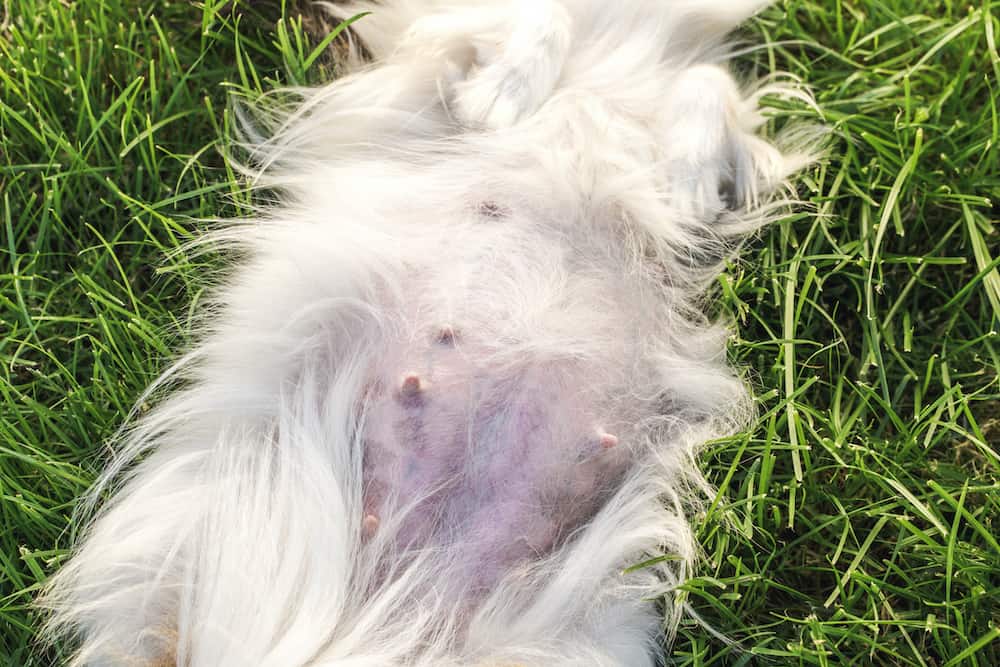
Week 5 (Trimester 2)
At this point, the dog is smack in the middle of their pregnancy. This is where the majority of the physical and behavioral changes start to be more pronounced and potentially problematic.
At this stage, the puppies are in their fetal stage of development. One of the main changes occurring inside is that their organs begin to form.
In fact, by the 28th to 30th day there is a detectable heartbeat.
Physically, the nipples continue to grow larger and darker. The dog will also start putting on a lot more weight, more rapidly especially around the abdomen. You may also notice some colorless, odorless discharge from the vagina at around the 28th day onwards.
There are also several behavioral changes to keep an eye out here.
The dogs tend to have higher appetites. They also may either become more affectionate or more reclusive. Finally, the dog may start needing more potty breaks.
The most important thing for you to do here is to keep up with the dog's growing dietary demands. This includes increasing their daily caloric intake. It is best to consult a vet in this case to ensure you are giving the pooch the right amount.
Calcium supplements should also be started early in the 5th week to support skeletal development of the fetus. The Revival Animal Health Breeders' Edge Oral Cal Plus Calcium Supplement definitely worth checking out in this case.
Week 6 (Trimester 2)
By around the 40th day of pregnancy, the dog's weight should have increased by 20 to 50% of their original body weight to support a healthy pregnancy. In order to keep up with these demands, consider switching your dog's diet to something healthier, more organic, and appropriately balanced.
We recommend Raw Wild. The unique, natural alternative is rich in both micros and macros needed for the dog's health and optimal development of the puppies that they are carrying. It is also very calorie dense which is important with healthy weight gain during the pregnancy.
RAW WILD is sourced from nature, not a feed lot. #GoWild
Just make sure to include dog-friendly vegetables and fruits to their diet to cover all the requirements.
Other than the marked weight changes, there are hardly any new developments in this week other than marked darkening of the abdominal area. The nipple changes as well as behavioral changes that started in the 5th week are just intensified.

Week 7 (Trimester 3)
The most notable change during the 7th week of pregnancy in a dog is how large, and tout the abdomen becomes.
As this happens, the fur around the dog's abdomen will start shedding at a very high rate.
All this is as a result of the growth of both the fetuses and their amniotic sacs. The little puppies at this point are almost fully formed.
In fact, major external structures including fur have fully formed by the 49th day of pregnancy.
The increase in weight from the growing puppies and their own weight gain could also slow the dog down significantly and leave them with very little energy. The best way to take care of them here is by keeping them comfortable, hydrated, and fed
Another major change that may start in the 7th week of pregnancy in a dog is production of colostrum. This is nutrient-rich milk produced for the puppies and can appear by the 50th day of the pregnancy.
Your dog's nipples may be very sensitive in this case. All you can do is wipe off any milk to prevent clogging and infections to their nipples.
Check out the list of dog wipes that we recommend right here.
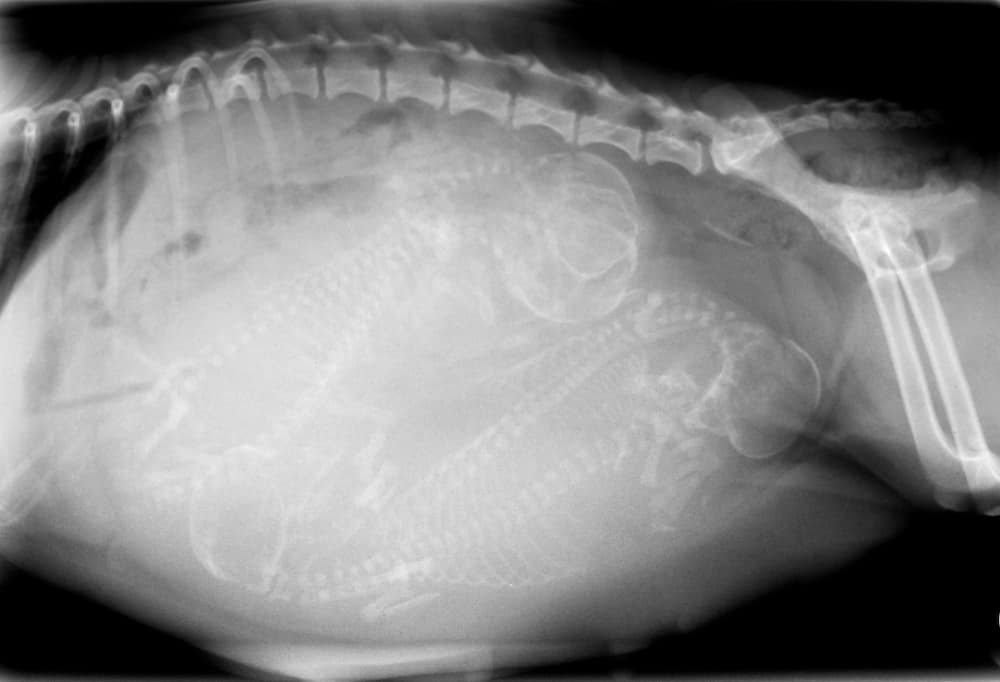
Week 8 (Trimester 3)
For the most part, there are hardly any new physical changes from what you may already have noticed in the preceding weeks of pregnancy. However, you may start to notice the little puppies moving around in their mother's belly as early as the 56th day.
Most changes during this week are behavioral. These include reduced appetite which could occur at around day 61.
The main reason for this is reduced stomach capacity as it is compressed by the growing uterus. The best solution here is to adopt a free-feeding schedule where the dog can eat whenever they have their appetite back.
You may also notice what is referred to as nesting actions.
This is instinctive behavior where the dog tries to create a nest for the coming puppies from anything they can find. This could be clothes lying around your home or even papers that they gather.
To avoid having the mess, simply create a nest for them with a comfortable dog bed and some blankets preferably close to where they will give birth if it will be done at home.

Week 9 (Trimester 3)
The 9th week runs from the 57th day to the 63rd but can go as far as the 70th in overdue dogs.
The dog could actually go into labor and give birth at any moment.
During these final days of the pregnancy, the dog will become more reclusive. They may stick to the nest they created or you created for them and hardly ever move for anything. Their appetite is also greatly reduced.
All you can do as the owner in this case is monitor them for any signs of labor like increased body temperature, pacing, and contractions visible through the abdomen. You should also look for danger signs like bleeding, dark-tinged amniotic leaks, or even prolapsed cords and puppy limbs.
It is also very important during this stage to have a vet on call and to keep them updated in case of any emergency.

Giving Birth
The process by which a dog gives birth is known as whelping. In most cases, the dog can do it all by themselves. However, it is still important to monitor the process in case of complications like dystocia or retained placentas.
The birth itself takes place in 3 major stages.
The first stage is marked by regular contractions and cervical dilation. This could last between 6 to 12 hours. You will notice that your dog becomes restless and starts to pace while also displaying nesting behavior.
The second stage includes delivery of the puppy.
Lastly, the third stage is marked by passing of membranes including the placenta.
Due to the fact that the dog will often give birth to multiple puppies, the second and third stage alternate as each puppy comes out with their membranes.
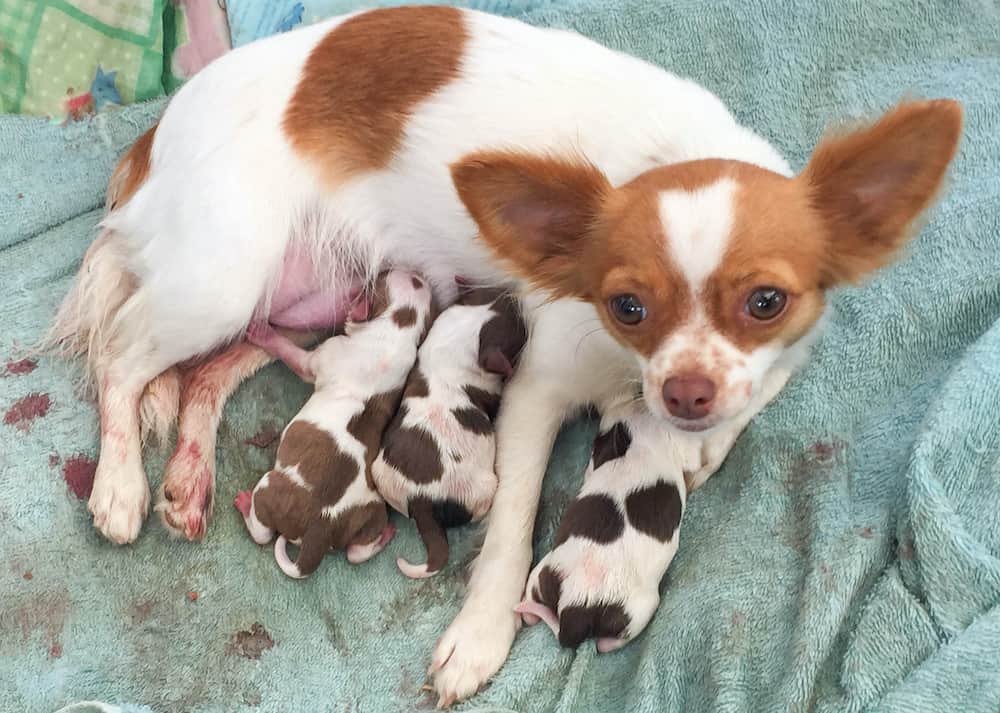
Postnatal Care
The postnatal period in the dog begins when the last puppy's membranes are delivered.
It is a very serious period as the dog is prone to a number of complications including excessive hemorrhaging as well as infections.
Constant monitoring for bleeding as well as the temperature is therefore very important.
The dog will also need as much support as possible with their new lactation demands. A healthy diet will go a long way in this case.
Royal Canin Mother And Baby Dog Food is particularly awesome for small dogs who need the support the most. It is specifically formulated for the high energy needs of the small breed dogs as they sustain their dependent pups.
The best part is that it can be rehydrated to a puppy-friendly porridge consistency that is useful when weaning to solid foods.
In addition to the healthy diet, postnatal supplements are also important to keep the dogs healthy and strong enough to support their puppy's nutritional needs.
We recommend Revival Animal Health Breeders' Edge Oxy Momma Postnatal Supplement available in formulations for large and medium dogs and for small breed dogs.
Related Question# 1: How Can You Tell If A Dog Is Pregnant Without Going To The Vet?
The best way to tell if a dog is pregnant is by looking out for physical and behavioral signs of pregnancy. The most obvious is an increase in weight both generally and around the abdominal area. Other signs include:
- Appetite changes
- Nesting behavior
- Increased affection and clingy behavior
- Low energy levels
Can A Dog Be Pregnant For 70 Days?
While a dog's pregnancy typically lasts 60 to 65 days, it is possible to have a pregnancy of up to 70 days or more. At this stage, the dog is considered overdue and could be at risk of complications to both the dog and their unborn puppies. It is therefore something you should consult your vet on as soon as possible.
How Can You Tell How Many Puppies A Dog Is Having?
You can usually predict the potential number of puppies based on a specific breed's average litter size. However, the most accurate way to tell how many puppies your dog is having is through an ultrasound. The vet could also use other methods including palpating the dog's abdomen and counting manually.
How To Estimate Your Dog's Due Date?
Childbearing and delivery is a huge deal, be it humans or your very own pet. Calculating their due date, caring during the process, caring post delivery and being prepared for the delivery are all very interesting and beautiful. This article will help you do just that - to estimate delivery date and preparation tips.As a general rule, the normal gestation period of a female dog will vary anywhere between 58 to 68 days from the first day of their mating, with 63 being the average number of days, which is roughly around two months.
Alternatively, to ease your job, you can simply estimate the due date by using a canine due date calculator. You will need to input the date of the first mating and in return, you will get the expected dates as the output. These calculators are very useful and will provide you with a detailed week-by-week expectation chart based on the due date calculation.
However, if you are not sure when your dog got pregnant, you can always consult your veterinary doctor for medical assistance.

